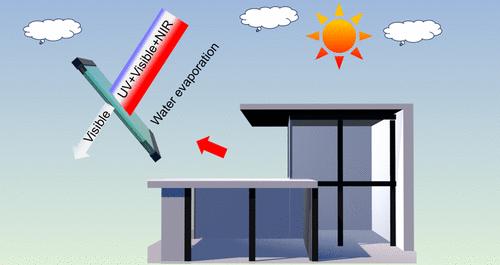紫外线固化坚固和透明双层膜的窗户收集水和房间冷却
IF 3.9
2区 化学
Q2 CHEMISTRY, MULTIDISCIPLINARY
引用次数: 0
摘要
由于全球变暖,冷却系统对能源的需求不断增加,这是一个重大挑战。传统的空调方式会增加碳排放,从而加剧气候变化。玻璃外墙,在现代建筑中以其多功能性和美学吸引力而闻名,无意中捕获太阳辐射,导致热量积聚和温室效应。为了解决这些问题,我们利用滚平和光固化技术,在紫外线(UV)粘合剂的帮助下,在玻璃基板上开发了水凝胶涂层。这种含水的水凝胶选择性地吸收紫外线和红外光,同时允许可见光透射,从而保持玻璃的透明度。利用部分紫外线和红外线的吸收作为主动冷却,利用水的液-气相变焓作为被动冷却,水凝胶在0.75太阳照射下显著降低室温高达8.1°C,相当于房间总冷却功率约为192.6 W m-2。本研究介绍了一种在玻璃建筑中实现透明和节能冷却的新方法,并增加了水资源回收的潜力。本文章由计算机程序翻译,如有差异,请以英文原文为准。

UV-Cured Robust and Transparent Double-Layer Membrane on Windows for Water Harvesting and Room Cooling
The increasing demand for energy in cooling systems due to global warming presents a significant challenge. Conventional air-conditioning methods exacerbate climate change by contributing to heightened carbon emissions. Glass facades, renowned in modern architecture for their versatility and aesthetic appeal, inadvertently trap solar radiation, resulting in heat buildup and the greenhouse effect. To tackle these issues, we utilized roll-to-flat and light-curing technology to develop a hydrogel coating on a glass substrate with the assistance of ultraviolet (UV) adhesive. This water-contained hydrogel selectively absorbs ultraviolet and infrared light while allowing visible light transmission, thereby maintaining glass transparency. Leveraging the absorption of partial ultraviolet and infrared as active cooling and the liquid-to-gaseous phase change enthalpy of water as passive cooling, the hydrogel significantly reduces room temperatures by up to 8.1 °C under 0.75 sun irradiation, corresponding to a total room cooling power of about 192.6 W m–2. This study introduces a novel approach to transparent and energy-saving cooling in glass buildings, with the added potential for water resource recycling.
求助全文
通过发布文献求助,成功后即可免费获取论文全文。
去求助
来源期刊

Langmuir
化学-材料科学:综合
CiteScore
6.50
自引率
10.30%
发文量
1464
审稿时长
2.1 months
期刊介绍:
Langmuir is an interdisciplinary journal publishing articles in the following subject categories:
Colloids: surfactants and self-assembly, dispersions, emulsions, foams
Interfaces: adsorption, reactions, films, forces
Biological Interfaces: biocolloids, biomolecular and biomimetic materials
Materials: nano- and mesostructured materials, polymers, gels, liquid crystals
Electrochemistry: interfacial charge transfer, charge transport, electrocatalysis, electrokinetic phenomena, bioelectrochemistry
Devices and Applications: sensors, fluidics, patterning, catalysis, photonic crystals
However, when high-impact, original work is submitted that does not fit within the above categories, decisions to accept or decline such papers will be based on one criteria: What Would Irving Do?
Langmuir ranks #2 in citations out of 136 journals in the category of Physical Chemistry with 113,157 total citations. The journal received an Impact Factor of 4.384*.
This journal is also indexed in the categories of Materials Science (ranked #1) and Multidisciplinary Chemistry (ranked #5).
 求助内容:
求助内容: 应助结果提醒方式:
应助结果提醒方式:


